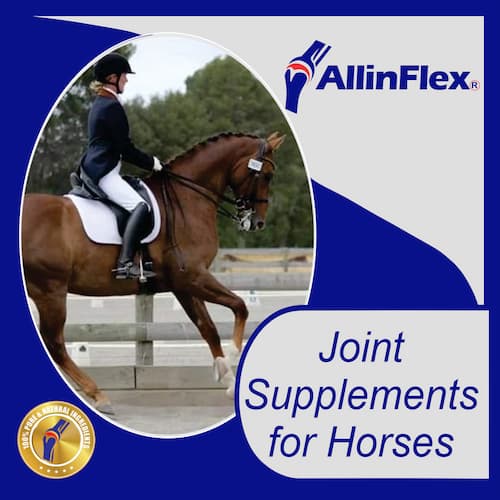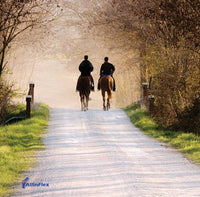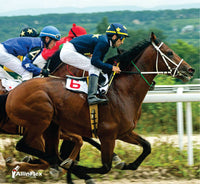Understanding the Horse's Hock Joint: Strains, Symptoms, and Treatments across Equestrian Disciplines
Saskia OstermeierHorses, an integral component of their skeletal system is the hock joint, a nexus of movement and power in a horse's hind leg, analogous to a human ankle.
Horses, remarkable creatures of strength and beauty, possess a complex anatomy designed for speed, agility, and endurance. Understanding the structure and function of this joint is fundamental for horse owners, riders, and equine enthusiasts alike.
It is also crucial to be familiar with the challenges that different equestrian disciplines can impose on the hock joint and the potential issues that may arise.
Before we delve into the specifics of the hock joint, it is beneficial to first understand the broader context of a horse's anatomy, particularly the structure of their legs.
A horse's leg is a marvel of biological engineering, designed to support the horse's weight and enable its impressive speed and agility. The equine legs comprise a series of bones, tendons, ligaments, and joints, all working in harmony to provide strength, flexibility, and shock absorption.
Focusing on the horse's hindquarters, we find the pelvis connecting to the femur, which articulates with the tibia at the stifle joint, a structure comparable to the human knee. The tibia extends downwards and terminates at the hock joint, connecting to the bones of the lower leg and ultimately, the horse's hoof.
This fundamental anatomy is crucial to understanding the function and significance of the hock joint. As we shall see, the hock is more than just a connection point within the skeletal structure; it is a dynamic and complex joint that plays a pivotal role in a horse's locomotion and athletic performance.
What is the Hock Joint on a Horse?
The hock joint, or the tarsal joint, as it is also known, is a complex structure located at the rear of a horse's hind limb. Playing a crucial role in a horse's locomotion, the hock joint functions much like a human's ankle, albeit with a more intricate structure and an increased workload.
The hock is located between the tibia – the large bone in the gaskin, which is the area akin to our calf – and the cannon bone in the lower leg. It acts as a hinge, allowing the horse to flex and extend its hind limb. This function is vital for propulsion, giving the horse its ability to gallop, jump, and perform complicated dressage moves.
In essence, the power generated in a horse's movement, particularly in the hindquarters, is channelled through the hock joint, making it a crucial component in a horse's overall athletic performance.
Despite its hard-working nature, the hock is a robust joint, well-equipped to handle the significant strains placed upon it. However, like any structure subjected to constant use and force, it can succumb to wear, tear, and injury, resulting in discomfort for the horse.
The Four Joints in the Equine Hock
In the realm of equine anatomy, the hock joint stands out as an intricate structure composed of not one, but four distinct joints, each with its own role and significance. Let's explore each of these joints in detail:
Tibiotarsal joint (or Tarsocrural joint): This is the largest and most proximal joint in the hock. It's where the tibia, the main bone of the horse's gaskin, meets the three tarsal bones: the talus, calcaneus, and the central tarsal bone. As the primary hinge in the hock, this joint facilitates the main flexion and extension movements of the hind limb.Proximal intertarsal joint (or Talocalcaneal-centroquartal joint): This joint is located just below the tibiotarsal joint and connects the talus and calcaneus to the centroquartal bone. This joint shares a joint capsule with the tibiotarsal joint, meaning they work together during movement.
Distal intertarsal joint (or Centrodistal joint): This joint is positioned below the proximal intertarsal joint and connects the centroquartal bone to the tarsal bones III and IV. Although it has less movement than the tibiotarsal joint, it plays a role in the overall flexibility of the hock.
Tarsometatarsal joint: The most distal joint in the hock, the tarsometatarsal joint connects the tarsal bones to the long metatarsal bones (the equivalent of our foot bones) of the lower leg.
Together, these four joints allow for the complex movements of the hock and enable a horse to effectively use its hindquarters for propulsion.
However, the intricate structure of the hock also means that it is susceptible to various injuries and conditions, something we'll explore further in the following sections. Understanding these potential problems and how to spot them is key to maintaining the health and wellbeing of your horse.

Common Issues with the Hock Joint
As a hard-working joint in the horse's body, the hock is prone to a range of issues stemming from natural wear and tear, injury, or disease. Being familiar with these conditions is vital for horse owners and riders, as early detection often leads to better treatment outcomes.
Here are some common hock joint problems:
Osteoarthritis: Also known as degenerative joint disease (DJD), osteoarthritis is a progressive condition that involves the deterioration of the joint's cartilage. In the hock, this primarily affects the lower joints (the distal intertarsal and tarsometatarsal joints).
Bone Spavin: This condition is a type of osteoarthritis that specifically affects the lower hock joints. Bone spavin can cause lameness and is often associated with bony growths on the joint.
Bog Spavin: Bog spavin involves swelling of the tibiotarsal joint due to excess synovial fluid. While not typically painful, it can indicate strain or damage within the joint.
Capped Hock: This condition presents as a swelling at the point of the hock, often caused by injury or trauma, such as bumping the hock against a hard surface. While generally cosmetic, severe cases can lead to lameness.
Curbs: A curb is a swelling or thickening on the back of the hock, usually due to damage to the plantar ligament. Lameness may occur in severe cases.
Tarsal Coalition: This is a rare congenital condition where two or more tarsal bones are fused, limiting the hock's flexibility.
Signs and Symptoms of Hock Joint Issues
Equipped with an understanding of the common issues affecting the hock joint, the next step is to learn how to recognise their symptoms. Horses can't tell us when they're uncomfortable, so it's up to us to interpret the signs they give.
Here are some of the key symptoms indicating potential hock joint problems:
Lameness: This is often the most noticeable sign. The horse might start limping, show an irregular gait, or seem reluctant to move. Lameness might only be apparent under certain conditions, such as during specific movements, after exercise, or in cold weather.
Swelling or Heat in the Hock: Any unusual enlargement or warmth in the hock region could indicate inflammation due to injury or disease.
Difficulty in Movement: Horses with hock joint problems may have difficulty with certain movements. This could manifest as resistance to making sharp turns, difficulty in performing specific dressage movements, or reluctance to jump.
Changes in Behaviour or Performance: Horses in pain might show changes in their behaviour, such as restlessness, irritability, or a lack of focus. In competition horses, you might notice a decline in performance or a lack of enthusiasm during training.
Altered Standing Position: Horses with hock issues might stand with the affected leg extended behind their body, in an attempt to relieve pressure on the joint.
Physical Abnormalities: In certain conditions, you might notice physical changes, such as bony enlargements in the case of bone spavin, or fluid-filled swellings in bog spavin.
Recognising these signs early on can lead to prompt treatment and potentially prevent further deterioration of the condition.

The Best Treatment for Hock Arthritis in Horses
One of the most common ailments that affect the hock joint in horses is arthritis, specifically osteoarthritis or bone spavin. This degenerative condition can significantly impact a horse's mobility and quality of life. Therefore, it's crucial to understand the best treatment options available.
Veterinary Diagnosis: If you suspect your horse is suffering from arthritis in the hock joint, the first step is a thorough veterinary examination. This will typically involve a physical exam, lameness evaluation, and imaging (such as X-rays or ultrasound) to confirm the diagnosis and determine the severity of the condition.
Non-Steroidal Anti-Inflammatory Drugs (NSAIDs): These are often the first line of treatment to manage pain and inflammation. They must be used under veterinary supervision, as long-term use can have side effects.
Intra-Articular Injections: These injections, commonly corticosteroids, are administered directly into the affected joint to reduce inflammation. Other substances, such as hyaluronic acid or platelet-rich plasma (PRP), might also be used to promote joint health.
Physiotherapy and Exercise Management: Controlled exercise, physiotherapy, and stretching can help maintain joint mobility and muscle strength. A tailored exercise program can also help manage the horse's weight, reducing unnecessary strain on the joints.
Joint Supplements: Oral joint supplements, such as glucosamine and chondroitin, can support joint health and may slow the progression of arthritis.
Surgical Treatments: In severe cases, surgical intervention may be required. This can include arthroscopic surgery to remove damaged cartilage or a procedure known as chemical fusion to alleviate pain in the lower hock joints.
Alternative Therapies: Treatments like shock wave therapy, laser therapy, acupuncture, and massage might also benefit some horses.Remember, each horse is unique, and what works for one may not work for another. Always consult with your vet to determine the best treatment plan for your horse.
Strain on the Hock Joint: Dressage vs Show Jumping vs Eventing
Different equestrian disciplines place varying demands on a horse's body, and understanding these distinctions is vital when considering the potential strain on the hock joint. Here, we'll discuss the specific stressors involved in dressage, show jumping, and eventing.
Dressage: This discipline requires precision, control, and a high degree of flexibility and strength from the horse. Movements like piaffe, passage, and pirouettes place a significant load on the hock joint. Sustained periods of collection and the frequent direction changes in lateral movements can lead to increased wear and tear.
Show Jumping: Show jumpers require explosive power to clear jumps, which places a high degree of concussive force on the hock joint upon landing. The sharp turns and fast, tight courses can also stress the hock, increasing the risk of sprains and strains.
Eventing: As a multi-discipline sport involving dressage, cross-country, and show jumping, eventing can subject the hock joint to a variety of stressors. The long, strenuous cross-country phase, in particular, can lead to fatigue-related injuries, while the jumping elements present similar challenges to those in show jumping.
Managing these strains involves appropriate training regimens, preventative care like regular joint health check-ups, and ensuring the horse is well-conditioned and suited for its specific discipline. Understanding the unique demands of each discipline enables you to provide the best care for your horse, reducing the risk of hock joint injury and ensuring your equine partner stays in top form.

Preventive Measures and Care for the Hock Joint
Given the crucial role of the hock joint in a horse's movement and performance, implementing preventive measures and maintaining a proactive care routine is essential. Here are some strategies to help keep your horse's hocks healthy:
Regular Exercise and Conditioning: Consistent and appropriate exercise helps to strengthen the muscles supporting the hock joint, improve joint mobility, and maintain a healthy weight.
Proper Nutrition: A balanced diet is essential for overall health, including joint health. Certain supplements, such as those containing glucosamine, chondroitin or green lipped mussel powder might also benefit joint health.
Regular Veterinary Check-ups: Regular veterinary evaluations can help detect potential issues early before they become more serious problems.
Adequate Rest and Recovery: Allowing time for rest and recovery after strenuous exercise can help prevent overuse injuries.
Proper Hoof Care: Regular farrier visits and proper shoeing can prevent uneven wear and tear on the joints.
Appropriate Turnout: Regular turnout allows the horse to move freely, promoting joint health and mental wellbeing.
Use of Protective Equipment: Leg protection, such as boots or bandages, can offer support and protection during high-impact activities like jumping.
Appropriate Training and Riding Techniques: A well-balanced rider and correct training techniques can prevent unnecessary stress on the horse's joints.
Monitoring Changes: Keep a close eye on your horse's behaviour, movement, and physical condition. Any changes could indicate potential issues that need addressing.
Remember, prevention is always better than cure. By taking proactive measures, you can help ensure your horse's hock joints remain healthy, minimising the risk of injury or disease and maximising your horse's comfort and performance.
Conclusion: The Integral Role of the Hock Joint in Equine Health and Performance
The hock joint is one of the hardest working parts of a horse's body, playing a vital role in movement and power generation. Its complexity, while providing the horse with remarkable agility and strength, also makes it susceptible to a range of conditions that can impact a horse's health and performance.
Recognising the signs of hock joint issues, understanding how different disciplines place unique strains on the joint, and knowing the best treatment options for common ailments like arthritis are key aspects of responsible horse ownership.
Most importantly, implementing preventive measures can go a long way in safeguarding the joint's health, allowing your horse to perform at its best, whether in the dressage arena, over a challenging jump course, or during a demanding eventing competition.
In caring for the hock joint, you're not just looking after a crucial part of your horse's anatomy; you're ensuring the wellbeing of the whole horse. As equestrians, that should be our ultimate goal.




